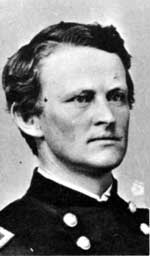|
FORT DAVIS National Historic Site |
 |

Fort Davis in October 1867, as it is being constructed. The view
is from the slope north of the post. In the cneter are the roofless shells of the
old stone barracks built in 1856 by Colonel Seawell. At the right are the scattered
ruins of the first fort and the camp of the 9th Cavalry; between the rows of tents
are temporary stables made of poles and thatched roofs. To the left of the
barracks, work is beginning on officers' row.
National Archives
Garrison of Fort Davis, 1867-81
THE 15 YEARS FROM 1867 TO 1881 spanned the period of active operations against hostile Indians in West Texas. The history of Fort Davis during these years is the history of four regiments, all Negro with white officers— the 9th and 10th Cavalry and the 24th and 25th Infantry.* Gradually the garrison grew from 4 companies of both infantry and cavalry to 12—from 8 officers and 200 enlisted men to 30 officers and 600 men. The 9th Regiment supplied the cavalry until 1875, when the 10th took over and served until 1885. The infantry were drawn from the 24th until 1870, from both the 24th and 25th until 1872, and from the 25th from 1872 until 1880.
Organized shortly after the Civil War, these regiments were composed largely of former slaves, and many in the Army and out watched them closely to see how the experiment would work. Like all other regiments, they had their share of bad soldiers. Led by some capable officers, however, the Negro units soon won a secure place in the frontier Army and for nearly three decades participated creditably in Indian campaigns all over the West. The troops stationed at Fort Davis compiled an impressive record in the late 1860's and the 1870's and played a significant role in destroying the Indian barrier of West Texas.


The 25th Infantry garrisoned Fort Davis during most of
the 1870's. These photos were taken about 1883, after the regiment had
transferred to Fort Snelling, Minn. In the officer group (top), Col.
George L. Andres, commanding officer, is seated in the center. At bottom,
a company of enlisted men of the regiment in dress uniform.
National Archives
Like the enlisted complement, the officer corps of Fort Davis usually contained a few men poorly equipped for the difficult task of presiding over the destinies of the troops they were supposed to lead. But most were capable professionals. Except for second lieutenants recently graduated from West Point, the officers were veterans of the Civil War. Some had commanded regiments, brigades, or even divisions in ranks much higher than the shrunken peacetime Army could now offer. Many held brevet ranks awarded for gallantry in action during the war, and it was not unusual for a first lieutenant or captain at Fort Davis to be addressed as major or colonel in recognition of his brevet grade.
 Lt. Col. Wesley Merritt, 9th Cavalry, reactivated Fort Davis in 1867 and commanded the post until 1869. This photo was made about 1864, when he lead a division of Sheridan's cavalry in the Civil War. National Archives |
 William R. (Pecos Bill) Shafter commanded Fort Davis in 1871-72 and again in 1881-82. Remington did this portrait in Cuba during the Spanish-American War. Denver Public Library |
As at all frontier forts, post commanders rotated with great frequency. Several in particular stand forth as unusually attentive to the condition of the post, the welfare of the troops, and the active prosecution of operations against hostile Indians. Lieutenant Colonel Merritt, who laid out the new post and built most of it, served from July 1867 until August 1869. He had been one of General Sheridan's most brilliant cavalry leaders during the Civil War, later made an impressive reputation against the Sioux on the northern Plains, and finally rose to command United States forces in the Philippine Islands after the Spanish-American War. Bvt. Maj. Gen. Edward Hatch, colonel of the 9th Cavalry, commanded the post from November 1869 to December 1870; 10 years later he played an important part in the war against Victorio's Apaches. Lt. Col. William R. Shafter, 24th Infantry, replaced Hatch and served until June 1872. One of the most colorful officers ever assigned to Fort Davis, "Pecos Bill" Shafter later led the United States Army in Cuba during the Spanish-American War. Other notable commanders were Maj. Zenas R. Bliss, one of Colonel Seawell's officers at Davis in the 1850's, and Col. George L. Andrews, who commanded for 4 years in the 1870's.
*The first infantry complement came from the 41st Infantry, which in 1869 was consolidated with the 38th to form the 24th.

|
|
Last Modified: Fri, Oct 18 2002 10:00:00 pm PDT |


